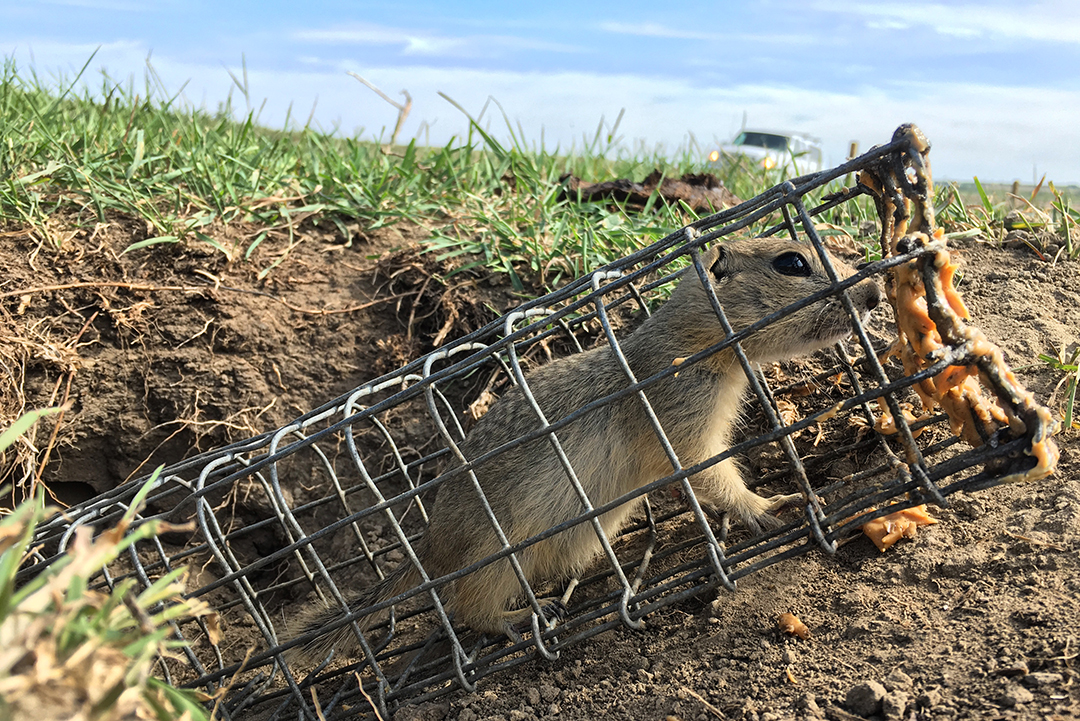
Investigating tularemia on the Canadian Prairies
Between June 29 and July 19, 1978, a group of seven monkeys at Winnipeg’s Assiniboine Park Zoo mysteriously fell ill.
By Morgan KelleyFour of the monkeys subsequently collapsed and died. On July 20, a day after being bitten on the right index finger by one of the sick monkeys, the zoo veterinarian complained of achiness and tenderness. He eventually developed enlarged lymph nodes.
Post-mortem examination of the monkeys’ livers and spleens revealed the cause — tularemia, an infectious disease caused by Francisella tularensis. Whereas outbreaks of tularemia have been documented to wipe out entire populations of wild rodents, the disease has a low mortality rate in people.
“Fortunately, tularemia is treated pretty readily with antibiotics as long as it is caught early,” says Dr. Dawn Abbott, a former graduate student in the WCVM’s Department of Veterinary Pathology. “It can be spread through contaminated water, through bites or inhalation. Things like inoculating ectoparasites, ticks, mosquitoes can potentially spread it as well. Human-to-human spread of the disease is not possible.”
Last summer, Abbott led a team of researchers that investigated the prevalence of tularemia in the Canadian Prairies. Right now there is relatively little understanding about the way in which the F. tularensis bacteria moves most efficiently through the environment.
Recognized as a highly infectious pathogen, F. tularensis can enter the body through a number of routes. Although the disease largely targets rodents, it is zoonotic and is primarily transmitted to people through bites from an infected animal or from an ectoparasite such as a tick or deer fly.
What remains a mystery decades later at the Assiniboine Park Zoo is where the bacteria resides. Is it harboured in the mice that inhabit the same building as the primates? Or is it circulating in the ground squirrels that can be found throughout the zoo?
To answer this question, Abbott collected blood samples from Richardson’s ground squirrels, meadow voles, flying squirrels and house mice at the Assiniboine Park Zoo.
By analyzing the blood samples for the presence of antibodies against F. tularensis, she was able to determine whether the animals had been in contact with the bacteria — an indication that F. tularensis is present in their environment.
She also collected ectoparasites such as fleas and live ticks since they contain blood from infected animals as well as any other animals they might have bitten that could now be carrying the bacteria and spreading it in the environment.
“Overall, the population of Richardson’s ground squirrels has looked healthy,” says Abbott. “But I have done an analysis on some of the liver samples and I am seeing that there is what we call hepatic necrosis, or areas of cell death, within the liver. That is one of the signs of tularemia. We don’t know yet if it is tularemia or if that is just an incidental finding, so we are flagging those samples to do polymerase chain reaction (PCR) testing to identify the cause.”
The information gathered through this research project will assist Manitoba’s Department of Public Health in designing preventive measures to protect people who come into contact with the ground squirrels at the zoo.
“Pretty frequently, the staff at the zoo see the ground squirrels come into contact with people,” says Abbott. “Visitors feed them, they’ve been seen in strollers with kids, and there’s been reports of the squirrels biting people.
"[The staff] have no idea when public health officials ask what the risk factors are. That’s how the project started, and we have expanded it to try and get a better understanding of the movement of this bacteria through the environment and where it is harboured.”
While Abbott’s research will be valuable to the Assinibioine Park Zoo, it will also provide important information about tularemia in the Canadian Prairies — the species that harbour the bacteria and those that spread it in the environment.
Morgan Kelley of Lethbridge, Alta., recently completed the fourth year of an honours biology degree at the University of Saskatchewan. Her story is part of a series of articles written by WCVM summer research students.
